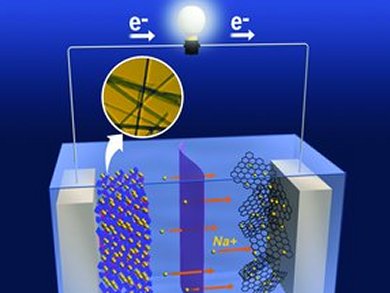Power generation from solar and wind energy sources fluctuates. To avoid overloading the electrical grid and to provide energy on demand, rechargeable batteries are required. Lithium ion batteries are too expensive for widespread use, but the cheaper sodium-ion batteries have lower energy densities or lose capacity after several recharging cycles.
Yuliang Cao and colleagues, Pacific Northwest National Laboratory, Washington, USA, have used Na4Mn9O18 nanowires heated to 750 °C to create a Na-ion battery with high capacity and exceptional cycling performance. The team measured a peak discharge capacity of 128 mA h g–1. After 100 cycles of charging-discharging, the battery lost only 7 % of its capacity and after 1000 cycles it maintained 77 % capacity retention, making it a promising candidate for a practical, low-cost Na-ion battery system.
Image: (c) Wiley-VCH
- Reversible Sodium Ion Insertion in Single Crystalline Manganese Oxide Nanowires with Long Cycle Life
Y. Cao, L. Xiao, W. Wang, D. Choi, Z. Nie, J. Yu, L. V. Saraf, Z. Yang, J. Liu,
Adv. Mater. 2011.
DOI: 10.1002/adma.201100904



